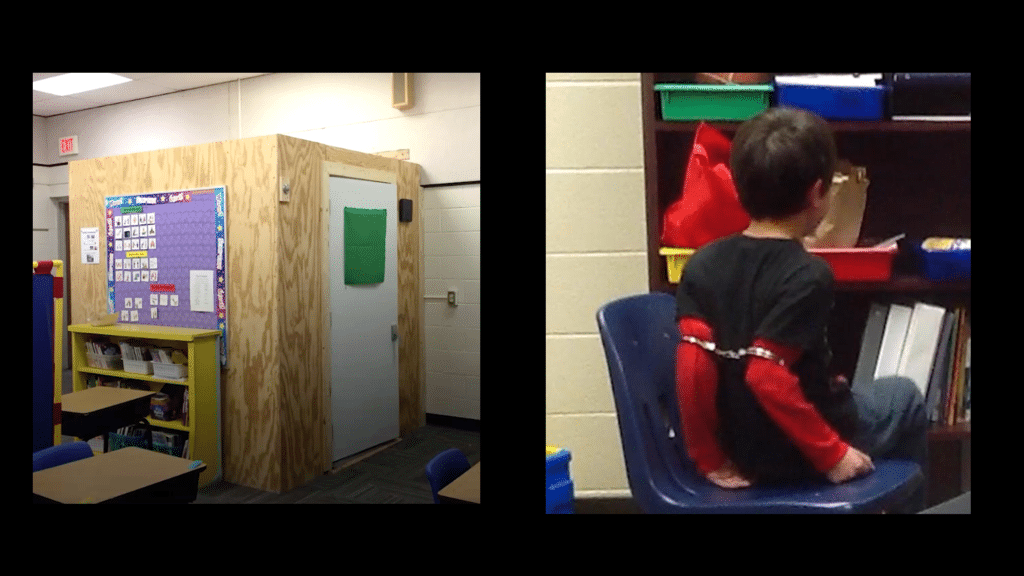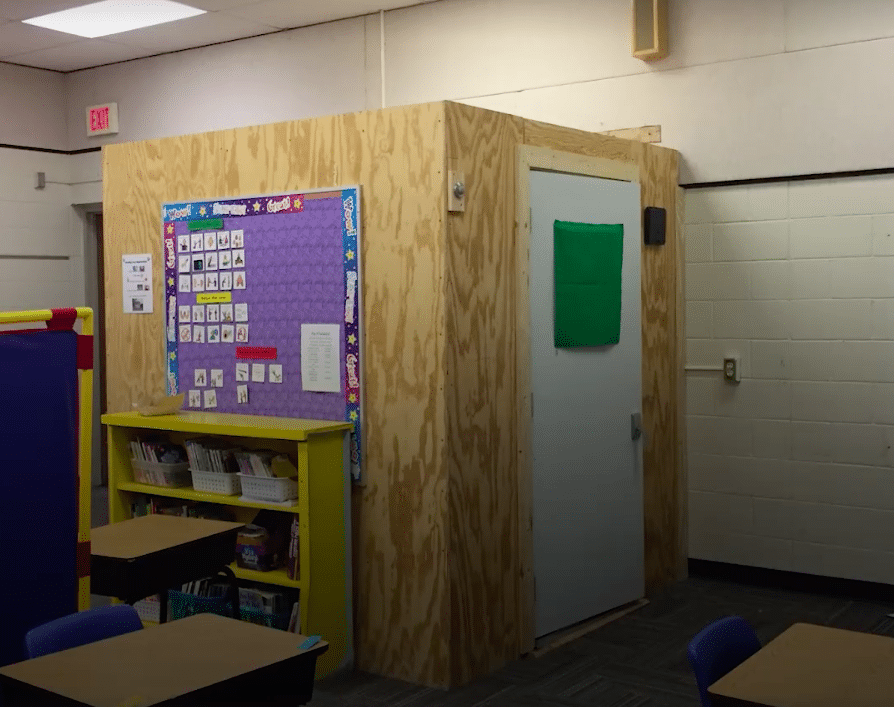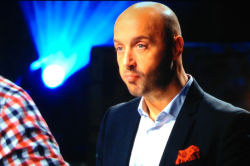
In the last few days, I have seen two stories that disturbed the hell out of me. We need to talk about them.
The Box
The first came from Iowa, where some schools have a practice of putting students in a plywood box that only opens from the outside as a form of punishment.

This picture haunts me. I’m imagining what this classroom must sound like, from outside the box, while a truly out-of-control child thrashes around inside. How that box must traumatize ALL students, even those who have never been placed inside it.
The Handcuffs
The other one is a 2015 story from Kentucky, where an 8-year-old boy was handcuffed for 15 minutes, above the elbows, by his school resource officer. If you’re able to watch this whole video, you have a stronger constitution than I do. I had to stop after 15 seconds.
This story reminded me of this other one, from South Carolina, when a student was flipped onto the ground and dragged out of class by her school’s resource officer after she refused to leave class with him:
If a school has resorted to these kinds of techniques for controlling student behavior, those in charge have lost the right to call themselves professionals.
We’re supposed to be the trained ones, the ones with expertise in child development, the ones who know how to de-escalate a conflict or pick up on early signs that a child is having a bad day and nip things in the bud proactively.
Even if a child is in danger of harming him/herself or others, there are more humane environments, more SOOTHING ways to calm them down. Because isn’t that our goal with a child who is actually physically out of control? To calm them down?
I can appreciate the desperation some educators must feel if they see an uptick in overwhelming, out-of-control behavior, and I am not suggesting we let kids remain in a classroom when their behavior has gotten violent or destructive, but this is not the way professionals handle things.
I am not saying we need to ignore misbehavior. I am not advocating for a lack of accountability. But this is not the way professionals handle things.
This is not the way.
Rather than just leave this here, feel disgusted, then move on, I have two calls to action for educators, administrators, and parents.
Call-to-Action #1: Say Something
This is not just about Iowa and Kentucky. It’s not just about South Carolina. I’m guessing plenty of other districts have their own “methods” they might not want spread all over the Internet.
If you are reading this and nodding your head, make this the week you go to your administration, to your school board, and say SOMETHING that will start the process of dismantling these practices.
Call-to-Action #2: Crowdsource a Better Way
These schools will not change unless they are shown a better way. Please share what you know about more humane, more effective approaches to managing behavior in schools. I’ll keep an eye on the comments and add good resources as they appear. Provide links if you can.
I’ll get us started:
Alternatives to Seclusion and Restraint
This is So Great, it is Painful
A post about an alternative school in the same district as the one in the plywood box photo where students are offered a calming, spacious room to calm down.
Proactive Behavior Management
Teaching with Love & Logic: Taking Control of the Classroom
Join my mailing list and get weekly tips, tools, and inspiration—in quick, bite-sized packages—all geared toward making your teaching more effective. You’ll get access to the members-only library of free downloads, including 20 Ways to Cut Your Grading Time in Half the e-booklet that has helped thousands of teachers save time on grading.




The pictures alone horrified me! I can’t really believe this happening in schools today.
My school district offers NCI training for any staff member in the district and refresher classes are offered for them to get recertification every 2 years. The training is voluntary, but schools strongly encourage all teachers, not just special education teachers, to take the training.
Yes, I think there can be better protocol when it comes to behavior that spirals out of control.
I’ve seen it up close when it made sense to seclude a child due to extreme behaviors that involved hurting others and himself. Total hazard, but it takes a two man team to carefully remove the child from the source of anger. I worked in an autism school at this time. I was thankful we had tools to help children calm down, but from an outsider perspective I can see how it would look horrible. It was only ever used as a last ditch effort. We always used positive reinforcement and went to great lengths to search for the good, but even autistic kids have bad days.
I’ve been on the receiving end of abusive behavior when I wished there was a big room that was padded where my student could calm down. But we did not have that in place. Instead, the kindergarten room was evacuated except for myself and my autism student. She continued to throw chairs, books, kick and punch me. And yet, there was nothing I could do but allow her to continue. She was beyond reach. No words I used made a difference. Any gentle touch or eye contact caused her to rage more. All I could do is stand there and take it. Needless to say, I left the job because there was nothing to support me in the future when it happened again, no support from the admins. It was sad. I look back on that time with disappointment. I felt like what we had to offer with inclusion and special ed failed this girl at many, many levels.
Handcuffs are wrong. Little time-out rooms are wrong. But leaving teachers to feel out of options is not okay either. When students with challenging behaviors are present in the school, we need highly trained professionals at their side. We need admins to be in the classroom to see first hand the realities of what happens EVERY DAY.
School should be a safe place for students and teachers.
I’ve had some very similar experiences, even as a first year teacher. We are often not equipped to properly deal with student behavior, and sometimes we are and it still isn’t enough. While I think it’s horribly sad what goes on sometimes, I also know that there is only so much time, only so many personnel, only so much space and so many optIons. Hopefully everyone will continue to develop and work together to find ways that are feasible for the teacher and loving for the child.
Ross Greene’s approach is a better, more humane approach to discipline. He starts with the philosophy that kids do well if they can. Behavior “issues” arise when the demands of the environment exceed the child’s ability to manage. He wrote “Lost in School.” Here is an article: http://www.motherjones.com/politics/2015/07/schools-behavior-discipline-collaborative-proactive-solutions-ross-greene/. His website is https://www.livesinthebalance.org
Mickey, thank you so much for sharing these.
Let me second the importance of Ross Greene’s work.
It’s helped me a great deal at school and at home.
Horrific. I trained as a teacher some years ago, and as part of that training we visited an EBD school (school for children with emotional and behavioral difficulties). Even there, where the children had been excluded from at least 3 regular schools for issues (and would have been suspended many times before that), they wouldn’t treat them like that. If physical force was required, it would be to de-escalate as quickly as possible. Teachers there were trained properly, and we were told not to be surprised if while we were there a teacher had to hold a child down until they could be calmed down. The impression we got from our visits there was that the teachers really cared about doing their best for the kids, that there was respect on both sides. While I don’t know what happened to kids for whom even physical restraint and exclusion from the classroom was insufficient, I’m confident that handcuffs and boxes were never used.
Jennifer—thank for so kindly replying to my comment on your Facebook post about the use of these rooms. I’m a teacher in rural Iowa in a school district that has padded classrooms for students whose behavior becomes unsafe.
This story has been making the rounds and if I were in a different area of the country, I would be just as quick to judge. I absolutely disagree with the use of these “boxes”, yet all the reporting has left out some very critical pieces of information.
In the last several years, our governor, without authorization from the legislature, shut down all Medicaid funded mental health facilities. At the same time, our state government has made historic cuts to education, health care, and many other social programs. As a result of this perfect storm of no funding, our tragically underfunded schools have become the last available institution to treat young people with mental health issues.
Their parents and families are often also untreated, and no teachers have been trained to adequately support the kinds of behavior we are now seeing with alarming regularity: kids who purposely gag themselves until they throw up, hurl books and other objects across classrooms, scream obscenities, run from classrooms and out of our buildings, and much worse.
These rooms are not used as a consequence for children who merely talk back, nor are we seeing children for whom the principles written in Love and Logic will keep themselves or their classmates safe from harm.
Again, these padded rooms are not the answer, but I’ve added more to your comment section to provide a fuller picture of how and why they are in use.
I can’t stress this next point strongly enough: these state legislatures are systematically working to destroy public education. By planting stories such as this one on sites with a liberal leaning bias (such as Huffington Post), they are winning at destroying any credibility that public education has left.
Please, do your research. Iowa is in crisis. Vote to protect public education and defy the powers that are working to divide us.
I have been reading “Unconditional Parenting” by Alfie Kohn and he even makes the case against time-outs. It was really hard to read but when it finally convicted me it made me think of how our small acts can lead to larger and more damaging acts that are seen in this article. Of course, padded rooms are not the answer and I have come to see Time-outs as also not the answer. We have the ability to help or hurt. Each one of our actions will weigh on these: Are we harming or helping?
Here’s another resource: “The Behavior Code: A Practical Guide to Understanding and Teaching the Most Difficult Students” by Jessica Minahan and Nancy Rappaport. The companion book: “The Behavior Code Companion: Strategies, Tools, and Interventions for support students with anxiety-related and oppositional behavior.” These books offer a systematic approach for figuring out “why” behavior is happening and then offers strategies to get kids back on track. Really good stuff!
In both videos on this page, it wasn’t the teacher handling the situation, but rather the school resource officers. I’m not entirely sure why teachers are the ones at fault here. Looks like maybe some training and anger management needed on behalf of the school resource officers.
Hi, Brooke–this is Holly, a Customer Experience Manager. I know Debbie sent this response via Facebook, but we want to take the opportunity to add to the discussion here as well!
We talked about this and appreciate the opportunity to clarify that the article was meant to be inclusive of all professionals who work with kids, more of a collective “we” of professionals, whether they be teachers, administrators, resource officers, school boards — anyone who works with children who would be part of these kinds of decisions. Thanks!
That is true. Also, I noticed some comments about how they can’t believe this is happening in schools today. When they make a general statement like that it seems like it is widespread. In 2009-2010 there were close to 100,000 public schools in America. This is extremely rare and again to reiterate these 2 instances were extreme because the police were involved but as usual teachers are taking the heat. I am not saying there hasn’t been any teacher that has inappropriately restrained a child or abused them but I am saying it is an extremely small percentage of teachers that do such horrible things. Honestly, these two examples shouldn’t even be on this blog post.
You’ve identified two powerful consequences to the assumptions that maintain punitive and behaviorist environments. Unfortunately there are many more but these two will suffice.
In my experience there are 4 things that all of us disliked or may resent about school: nagging, criticism, punishing, and bribery. These are the most common practices of an essentially behaviorist model; behaviorists believe that any behavior can be developed through a process of positive or negative reinforcement.
Many seem to agree that this environment is not ideal but few identify the underlying assumptions that must be in place for behaviorism to continue.
Dr. William Glasser wrote on this topic throughout the 2nd half of his career.
1. People respond to external stimulus. You answer the phone because it rings not because you think you may want to talk the person calling. (Now we rarely answer precisely because who we think might be calling us!)
2. I can make people do what I want them to do; people can control how I think, act, and feel.
3. It is our right, even our obligation, to ridicule, punish, nag, or bribe someone to get them to do something they don’t want to do.
I don’t think many people would happily agree they believe any of these statements. But, the logic is sound. How could you possibly punish a kid for a behavior if you didn’t also think you had the right to do so.
Anything that doesn’t address these assumptions will just be a repackaged behaviorism and fall to the same fate of every other behaviorist program.
Thank you for your writing! I look forward to seeing more from you!
Alfie Kohn has many thought-provoking articles on a range of school & child issues.
https://www.alfiekohn.org/
I just saw this blog post, and it caused a myriad of emotions for me. Our youngest is special needs and stories like these keep me awake at night. We have never seen this happen in our school, but there is still much room for improvement.
I appreciate the fact you encourage educators to take a stand but be proactive with ideas to help correct the situation. As someone who is in school to be a teacher, I love the way you encourage teachers to take a role in being the solution. Thank you.
Hey!
Thank you so much for taking the time to share this positive feedback! We are so glad that you are finding value in Cult of Pedagogy!